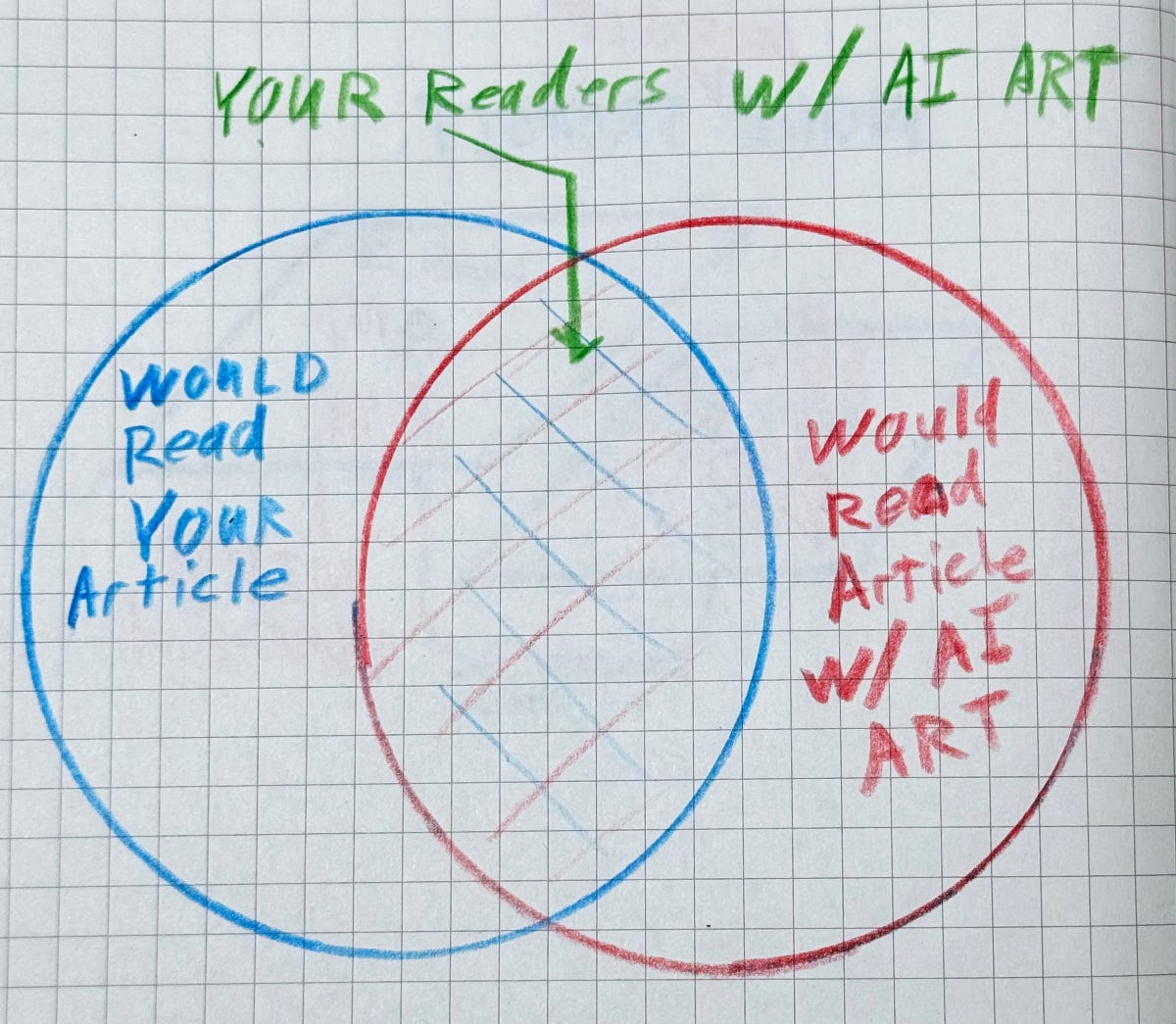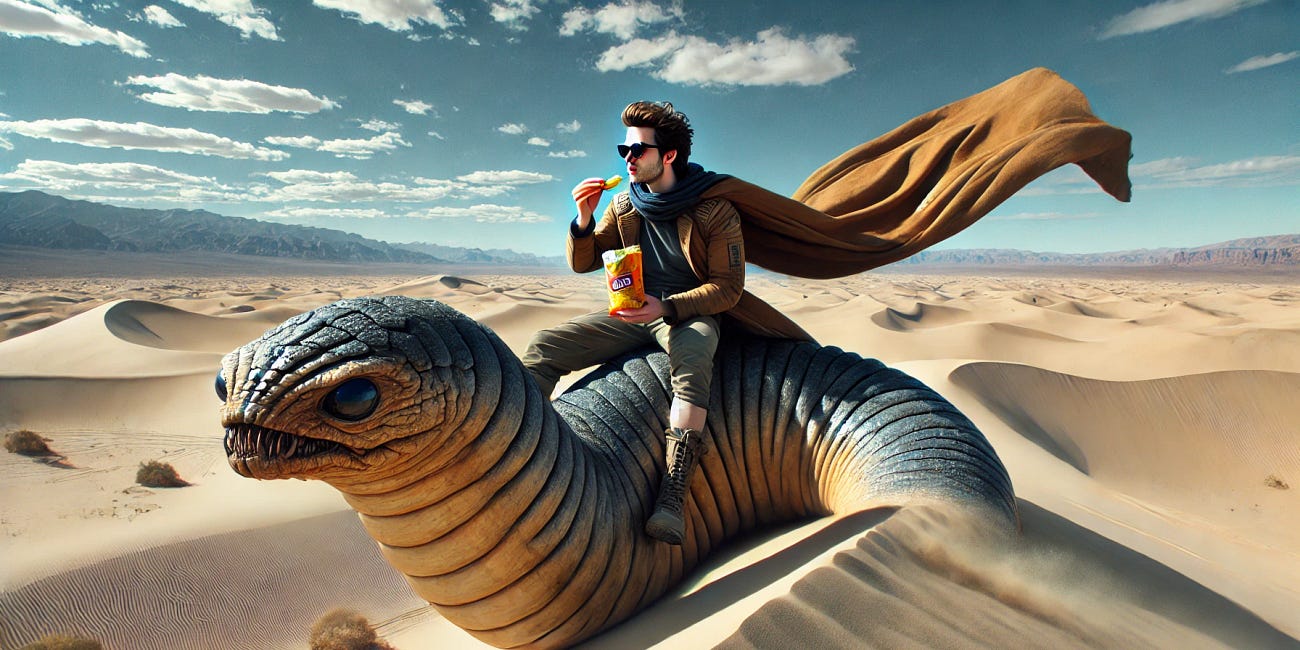Should You Use AI Art in Blog Posts?
Three questions to help you decide whether to use AI art and other AI media to support your content and blog posts
Some months ago I was introduced to the fact that the free version of ChatGPT can generate images. This is a pretty neat feature, which I’ve used in this publication from time to time. More recently, I’ve caught some flak1 for using such AI images. Is this criticism justified? Should I use AI art in my blog posts/newsletter? Should you?
The AI Image/No AI Image question comes down to two major factors:
Is using AI-generated images helpful for your goals?
Is using AI-generated images ethical?
Also, related to both: what’s the current and future legality of using AI-sourced images? I can’t directly answer these questions, but instead present a useful framework for your consideration. So, here we go:
Is using AI-generated images HELPFUL in blogs and newsletters?
Why would you use AI “art” when there is a vast array of other options that are arguably better? The answer: AI art is really easy to make2. Type in a few terms and out pops an image that (may) look pretty close to what you intended, albeit potentially featuring people with three pupils, four arms3, and other deformities and/or enhancements. If it’s not quite right, pop in a few more terms and you’ll eventually get something decent(ish) to break up your newsletter. but…

It’s typically rather obvious that what pops out is AI generated. Few really like AI art. Some, like the BSKY user Arya quoted below 👇 might actively pass up on reading your article, thinking that potentially the whole article is infested with AI drivel. This is backed up by the above 👆 poll.
And even if people think your writing is probably by a human, what looks more professional, an obviously AI image, or a nice polished image that a human made? Or even one that isn’t so polished. If your image isn’t great, but it’s obviously human, that adds authenticity to the article that it wouldn’t have otherwise.
Still others might get really angry about your article per the use of AI images. I think that is a minority, but between annoyance/anger and doubt about an article’s authenticity, there is a real cost to using AI art.
On the other hand, some people might give your article more attention/engagement because they really don’t like it. I’m not someone who thrives on controversy/bad vibes, but plenty of people do.
OK, one controversial opinion: I personally think AI art is neat. It often takes a certain style that’s colorful and hard to define4. At least sometimes. At other times it is really quite bad. Maybe I just haven’t seen enough of it.

THE QUESTION then becomes: does the benefit of using AI art to break up your articles outweigh any respect penalty? It’s not like you don’t have other choices, sources like Wikimedia allow you to use their content for free5. If you make and document things (like I do), you already have a repository of your own content from which you can choose.
You could also reach out to others via social media, etc, to see if there is someone with appropriate images that would be happy to be featured. This is a win-win, and they will likely check out your work and maybe even share it. (see end👇)
I’m now on the fence about whether AI art is useful, after not really giving it much consideration before. What about the ethics of AI art/content for blog writing support?
Ethical Justification #1: It’s YOUR work - you have a right to it!
Just because everyone is doing it doesn’t make something right. However, if you’re putting art/images/music/video on the Internet, there’s a very good chance that you are being used to train models that then generate “new” art.
You could therefore argue that since you have deposited an infinitesimally small portion “X” to this bank of knowledge, then it’s your right to withdraw an equally infinitesimally small bit of output “Y” from said bank. Everyone contributes, everyone gains.6 Like a bank where you can deposit and withdraw funds… even if you never actually set up an account there.7
Ethical Justification #2: This is what every artist and innovator has done forever
New inventions have always built on previous inventions, new art on old art, new works of fiction on old works of fiction. One might say that life trains us as humans in the same way that an “AI” is trained, amalgamating what we sense in new ways based on inputs you get over a lifetime.
AI just does that on a much larger scale. Imagine the world’s data is like a penny jar in a convenience store. You take a penny, no one cares. But you do it a couple million times, and it adds up to meaningful creative output.8
Ethical Condemnation: You’re stealing other people’s work
OTOH, no one (or at least not everyone) gave OpenAI et al the right to use their data for new image creation. They–and by extension you–are guilty of this immoral and potentially illegal act.
Justification #1 provides an argument against this condemnation as users, providing some compensation for whatever we’ve contributed. As far as the actual AI providers, which unilaterally decided this was a good deal (and got rich in the process), this sort of justification wouldn’t really make sense. Sort of an AI-ethical chicken-in-egg problem.
Legal Risks 🚔🤠
Currently AI is in a sort of Wild West stage, where you (as a user) wouldn’t typically be in legal jeopardy for using AI-generated images. At the same time, the legal landscape seems to be catching up. One could see a future where you could get sued for using AI-generated images, though who would be named as the victim is almost unknowable unless you’re a huge publisher.
Perhaps the risk is that at some point in the future you would need to change your website around to comply with new laws. Annoying, but not crippling. However, I am not a lawyer, and am largely coming at this article from a philosophical angle. I really don’t know, and I don’t think anyone else really does either–which actually sounds like a situation, i.e. risk, that large companies at least would want to avoid.
Where should YOU draw the line?
With a few minor exceptions (e.g. “make xyz title catchier”), TechAdjacent.io is written without the help of AI. At the same time, I use some images that are AI generated, and it works as a great research tool when I want to check figures and facts. I’ve also used AI-generated music in multiple posts (see below 👇), but I honestly got a little bored with it.
AI Music Creation Is Here: Will It Change Everything?
This weekend was Maker Faire Orlando, and as has become something of a tradition, I rented a house with friends* and fellow hackers Carl and Mr. Four Bits. As it turns out, Mr. Four Bits enjoys potato chips… which will become important later in this story.
One could argue that If I pride myself on making an AI-less publication, this should extend to the media embedded within. But what about for research? Is this OK? What if you have a coding question that you can’t solve? Can you ask ChatGPT? For that matter, should you use GitHub Copilot to code faster, or even enter the emerging world of vibe coding?
The Rise of AI-Veganism? 🍔
If you have a moral issue with AI images, music, video, or written content, then how can you in good conscience use any of them? You might argue that certain tools are different from others, but at the end of the day it’s all 1s and 0s. Perhaps you could be an AI-vegan in the tech and tech adjacent space, but this stance would currently be very difficult to maintain.
I would love to see is a world where each contributor to the world/Internet’s art and knowledge repository was compensated fairly, but that seems unrealistic for numerous reasons. Even if society/businesses wanted to, how could it be done?9
The idea for this article came from the exchange (partially) shown below. How cool is that. You can ask AI to generate something for you, or maybe someone else would take a REAL photo for you, hopefully enjoy being featured, and maybe even check out your work!

As always, thanks so much for reading! If you enjoyed this post (or even if you didn’t), please consider subscribing 👇 to get new posts via email!
Note that any Amazon links are affiliate
Addendum/Footnotes:
Per etymonline.com, the term “flak” originates from the German word fliegerabwehrkanone, literally "pilot warding-off cannon." Searching around in my mind I remember the word “strafe” being the German word for punishment (this is off the top of my head, and no I don’t speken German). Kind of a weird connection that both sides of an ground-air battle are described in English via words originating in Aleman, as the Spanish would say… Who also might say that this is my most random footnote ever.
Or “make,” if you so prefer. It appears that ChatGPT limits its AI image generation to three images per day these days. I’m not currently paying for it, so the output that I get is limited at best.
Goro - not AI generated? Seems like something AI would come up with (4 arms, 3 digits/hand). Also, how many abs does he have? A 12-pack? Possible evidence of AI time-travel capabilities.
Have to make nice with our future robot overlords. Maybe I just haven’t seen enough of it. Like Tesla’s Cybertruck, or the PT Cruiser of years gone by–they both seemed to look really cool at first, but after you see them over and over your opinion starts to shift. The unique Pontiac Aztek, however, never looked good. I suspect any actual Aztecs would have preferred it be named “Inka.” Or maybe they would prefer to play the designers of that vehicle in a “sudden death” handball game.
Also, there’s the whole Fair Use doctrine, which potentially opens up access to a lot of additional content (see Goro, footnote 3). This opens up a whole can of worms that I’m not prepared to discuss in terms of single image use. OTOH, this could be used as an argument for why AI training via the Internet’s repository of knowledge is OK.
Perhaps there’s some sort of techno-socialist argument to be made here.
See Superman III, or so Office Space tells me
Ironically, maybe AI could help with this. For past content it could figure out the probability of each bit of content’s source and how much it has been used, assigning a monetary account to each person. Perhaps going forward this would take the form of some sort of blockchain tracing on each bit of content to ensure each of us get the proper credit, which could even be a form of currency. I’m way out of my depth here, but it’s certainly… an idea.





I personally hate AI art, but I love your writing. I have spent many pleasant hours using the NYPL public domain image collection, though! You wouldn't believe the things I find!